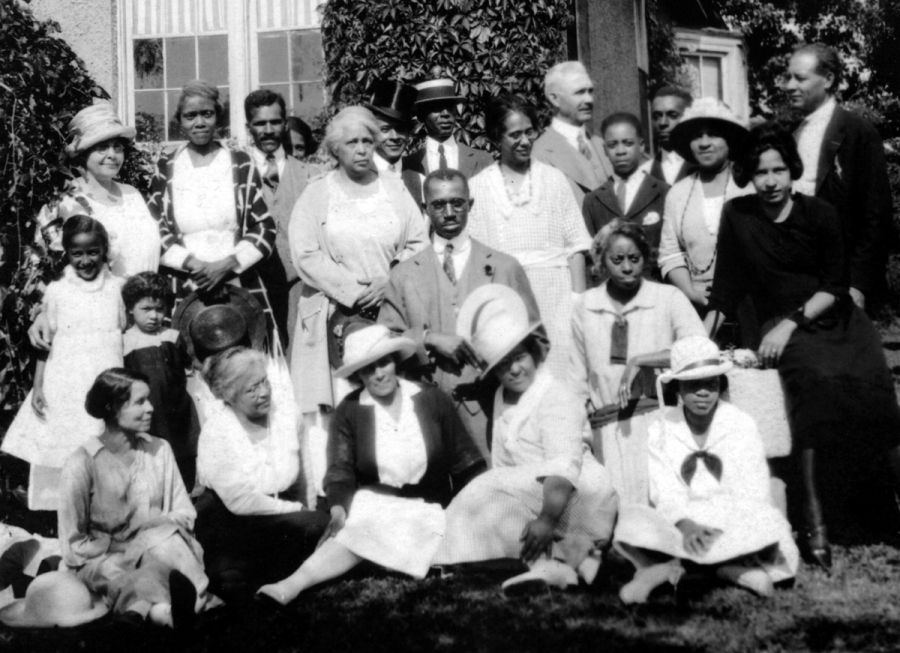— By Dino Robinson

Because neither Evanston Hospital nor St. Francis Hospital regularly admitted black patients except in special circumstances, two black physicians, Dr. Isabella Garnett and Dr. Arthur Butler founded and operated the Evanston Sanitarium. Eventually evolving to Community Hospital of Evanston, the Evanston Sanitarium provided health care for many black persons along Chicago’s North Shore from 1914 to 1980.
Dr. Garnett ran a general practice, delivering babies and administering anesthesia
In 1914 Dr. Garnett (1872-1948) and Dr. Butler (1879-1924) opened the Evanston Sanitarium in a house at 1918 Asbury Ave. Dr. Butler was the staff surgeon, and Dr. Garnett ran a general practice, delivering babies and administering anesthesia. Four years later, in 1918, the Evanston Sanitarium and Training School was incorporated, overseen by a biracial board of directors.
After Dr. Butler died in 1924, Dr. Garnett continued to operate the Evanston Sanitarium under the new name Butler Memorial Hospital.
In 1926, the biracial Booker T. Washington Hospital Association was formed to build a new hospital, which, according to its 1929 bylaws, would make “no distinction. . . on account of race, religion, or nationality, either as to officers, patients, attending physicians, interns, nurses, or other employees of the corporation.”
On Dec. 8, 1930, Community Hospital of Evanston opened an 18-bed hospital in the “Penn House,” the former home of Dr. A. Rudolph Penn, at 2026 Brown Ave.
Dr. Hill founded and headed the Woman’s Auxiliary
Elizabeth Webb Hill (1898-1978) joined the staff of Community Hospital in 1931 and was named chief of staff in 1943, becoming one of the first (if not the first) African American woman hospital chief of staff in Illinois. The same year, Community Hospital of Evanston received provisional accreditation pending construction of a new hospital building. In addition, Dr. Hill founded and headed the Woman’s Auxiliary whose purpose was to fund-raise on behalf of the hospital.

In 1950, Community Hospital of Evanston was awarded a matching grant under the Hill-Burton Act, saving the dream of opening a new larger hospital. Supporters of Community Hospital began to raise funds and lease land along the North Shore Channel next to the Penn House for the new facility. The new 56-bed hospital was dedicated on Oct. 5, 1952. This proved to be an example that cooperation between people of different backgrounds can work. By 1954, Community Hospital of Evanston obtained full accreditation.
During that same year, Dr. Hill warned Community Hospital’s board of directors that many black persons were choosing Evanston’s formerly all-white hospitals, which had begun to admit Black patients. In an attempt to attract black patients and retain black physicians, the hospital upgraded its programs and facilities in the 1960s.
However young black physicians were unwilling to have their primary affiliation with a small hospital like Community Hospital and opted for larger affiliations such as Evanston and St. Francis hospitals. Black patients also preferred to obtain health-care services at the larger hospitals.
In 1973 talks opened among Evanston Hospital, Northwestern University Medical School and Community Hospital of Evanston in an effort to insure the survival of Community Hospital. As a result, all the doctors at Community and Evanston hospitals received full staff exchange privileges. However, because of internal problems, the tripartite agreement fell apart. After 1975, most doctors formerly associated with Community Hospital had left. One last plea to revive the hospital came from the President of the Hospitals Board of Directors:
“. . .But Community Hospital is here, and there are many stories of vision, courage and heroism in its past. It not only has a glorious past, despite its origins, but it has a mission for the future.” —An open letter to all members of the Community Hospital Corporation, Pauline L. Williams
Evanston Hospital eventually bought the closed Community Hospital. In 1986, after local residents rejected various proposed uses for the facility, Over The Rainbow Association acquired the buildings. The one-story hospital building was converted to the Elizabeth W. Hill Arboretum Apartments, which provide integrated housing for the severely physically disabled. The Penn House, vacant for a decade, was demolished for a parking lot in 1992, despite a campaign and protest to try to save the building.
Sources: Shorefront Archives. This article first appeared in A Place We Can Call Our Home, 1995, 2013.
